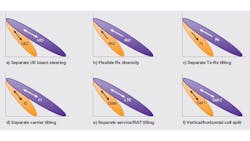As mobile networks begin reaching capacity, a number of opportunities to alleviate this problem are coming to light. Although adding more base stations has proven viable, it is a relatively slow and expensive solution. Smaller cells also have shown to be effective, but this approach is not an all-in-all fix. Active antenna systems (AASs), however, are now believed to have the potential to provide mass benefits industry-wide. With the massive deployment of time-division synchronous-code-division-multiple-access (TD-SCDMA) and time-division Long Term Evolution (TD-LTE) base stations, the active antenna market is heating up. According to Mobile Experts roughly 500,000 beamsteering antenna units will be deployed in 2013 alone.
Active-antenna-system technology integrates several RF components, such as power amplifiers and transceivers, with the antenna diploes. This enables the phase and amplitude of the signals from each dipole inside the antenna to be electronically controlled, thereby enabling more flexible deployment, improved coverage, smaller installations, and lower power consumption.
In a report from Mobile Experts, “Active Antenna Systems 2013,” researchers note that active antenna systems have the capability to boost capacity. They also point out, however, that this approach is expensive—especially compared to small cells and WiFi. In addition, there is a potential for error-vector-magnitude (EVM) distortion. AASs offer a good option for scenarios requiring in-band interference rejection. They also could be used when other HetNet alternatives are not feasible.
The report includes cost/benefit estimates and charts for a variety of AAS solutions, forecasts for integrated-antenna-radio (IAR) shipments through 2018, analysis of AAS shipments by beamsteering type (vertical sectorization, azimuthal beamforming, and beamtilt), and frequency band and competitive profiles of involved companies. As AASs support technologies like multiple-input multiple-output (MIMO) and higher-order receiver diversity (four-way receive diversity), the complexity of antenna selection and configuration will only increase in the race to provide higher performance.
Information for this article was found in the white paper, “Active Antenna Systems: A step-change in base station site performance,” by Nokia Siemens Networks.
About the Author
Iliza Sokol
Associate Digital Editor
Iliza joined the Penton Media group in 2013 after graduating from the Fashion Institute of Technology with a BS in Advertising and Marketing Communications. Prior to joining the staff, she worked at NYLON Magazine and a ghostwriting firm based in New York.
